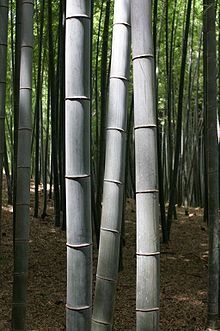Bamboo ![]() i/bæmˈbuː/ (Bambuseae) is a tribe of flowering perennial evergreen plants in the grass family Poaceae, subfamilyBambusoideae, tribe Bambuseae; although, the forestry services and departments of many countries where bamboo is utilized as a building material consider bamboo to be a forestry product, and it is specifically harvested as a tree exclusively for the wood it produces, which in many ways is a wood superior in strength and resilience to other natural, fibrous building materials. In fact it is often referred to as a tree by cultures who harvest it as wood. Giant bamboos are the largest members of the grass family. In bamboos, the internodal regions of the stem are hollow and the vascular bundles in the cross section are scattered throughout the stem instead of in a cylindrical arrangement. The dicotyledonous woody xylem is also absent. The absence of secondary growth wood causes the stems of monocots, even of palms and large bamboos, to be columnar rather than tapering.[1]
i/bæmˈbuː/ (Bambuseae) is a tribe of flowering perennial evergreen plants in the grass family Poaceae, subfamilyBambusoideae, tribe Bambuseae; although, the forestry services and departments of many countries where bamboo is utilized as a building material consider bamboo to be a forestry product, and it is specifically harvested as a tree exclusively for the wood it produces, which in many ways is a wood superior in strength and resilience to other natural, fibrous building materials. In fact it is often referred to as a tree by cultures who harvest it as wood. Giant bamboos are the largest members of the grass family. In bamboos, the internodal regions of the stem are hollow and the vascular bundles in the cross section are scattered throughout the stem instead of in a cylindrical arrangement. The dicotyledonous woody xylem is also absent. The absence of secondary growth wood causes the stems of monocots, even of palms and large bamboos, to be columnar rather than tapering.[1]
Bamboos are some of the fastest-growing plants in the world,[2] due to a unique rhizome-dependent system. Certain species of bamboo can grow 35 inches within a 24-hour period, at a rate of 0.00003 km/h (a growth of approximately 1 millimeter (or 0.02 inches) every 2 minutes).[3] Bamboos are of notable economic and cultural significance in South Asia, Southeast Asia and East Asia, being used for building materials, as a food source, and as a versatile raw product. Bamboo has a higher compressive strength than wood, brick or concrete and a tensile strength that rivals steel.[4][5]
The word bamboo comes from the Kannada term bambu, which was introduced to English through Malay.[6]



